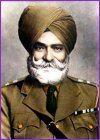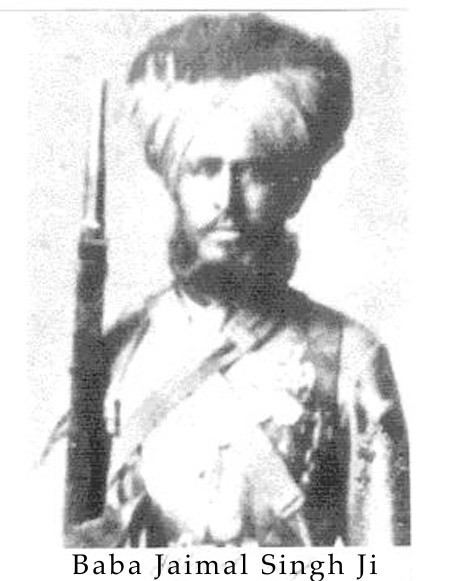Other names Baba Ji Maharaj Name Jaimal Singh Based in Punjab Province Website www.rssb.org | Period in office 1884–1903 Successor Sawan Singh | |
 | ||
Died 29 December 1903 (age 64) Punjab Province, British India Born July 1839 Ghuman (age 64), Amritsar District, Punjab Similar Sawan Singh, Jagat Singh, Ajaib Singh | ||
Baba Jaimal Singh (1839–1903), popularly called "Baba Ji Maharaj", was a Punjabi who became a disciple of Soami Shiv Dayal (the Sant Mat saint of Agra and founder of the Radha Soami spiritual movement). He served as a soldier (sepoy) in the British Indian Army attaining the rank of havildar. After retirement he settled in a desolate and isolated spot outside the town of Beas (in undivided Punjab, now east Punjab) and became a spiritual teacher. The place came to be called Dera Baba Jaimal Singh, and is now the world centre of the Radha Soami Satsang Beas organization.
Contents
- The Life and Wisdom of Baba Jaimal Singh of the Radhasoami Faith
- Youth and education
- Search and discipleship
- Ministry
- Teachings
- References

Baba Jaimal Singh was the first chief of Radha Soami Satsang Beas until his death in 1903. Baba Jaimal Singh granted his Will to Baba Sawan Singh and ordered him to succeed as the second RSSB Chief.

The Life and Wisdom of Baba Jaimal Singh of the Radhasoami Faith
Youth and education

Jaimal Singh was born July 1839 in the village of Lath Ghuman (Ghoman), near Batala, District Gurdaspur, undivided Puñjab, undivided India. His parents were Jodh Singh, a farmer, and Daya Kaur. His mother Daya Kaur was a devotee of Bhagat Namdev, and from the age of four Jaimal started visiting the local shrine dedicated to the memory of Namdev.
At the age of five Jaimal started his education with Baba Khem Singh, a Vedanti sage. Within two years Jaimal had become a good reader of the Guru Granth Sahib and also read the Dasam Granth.
At the ages of 12–13, he understood that the Guru Granth Sahib rejected pranayama, hatha yoga, Japa, places of pilgrimage, fasting and rituals as means to finding The One God described by Guru Nanak. Jaimal came to the conclusion that he had to find a master who practiced the meditation on the Anhad Shabad, the Inner Sound.
He especially wanted a master who could explain the Guru Granth Sahib's reference to the Panch Shabd, the Five Sounds. One such phrase is one from Guru Nanak:
Ghar meh ghar daykhaa-ay day-ay so satgur purakh sujaan. Panch sabad Dhunikaar Dhun tah baajai sabad neesaan.The True Guru, the All-knowing, Primal Being shows us our true home within the home of the self. The Five Primal Sounds resonate and resound within; the insignia of the Primal Sound is revealed there, vibrating gloriously.Search and discipleship
Between the ages of 15 to 17, Jaimal Singh undertook an arduous journey through North India on a lengthy quest for a teacher, having had decided at age 14 that he needed to find a Master of the Panch Shabd. In 1856, his travels culminated in Agra at the feet of his master "Soami" Shiv Dayal Singh who initiated him into the Practice of the Five Sounds.
After his initiation, Jaimal Singh was set on becoming a sadhu and devoting his attention full-time to abhyas (spiritual practice). His guru, however, told him that the followers of the Sant tradition earned their own living. Jaimal, on the other hand, had no inclination to follow his family tradition of farming since it would entail taking a wife. Hence, Shiv Dayal advised the teenaged Jaimal to join the Army.
Ministry
In October 1877, Shiv Dayal Singh instructed Baba Jaimal Singh to start preaching and initiating the holy Naam in Punjab and to spread it to all over the world, as the essence of Surat Shabd Yoga had been forgotten.
Jaimal Singh left the Army on June 7, 1889 and retired to his village. Later he built a hut at the village of Bal Saran on the banks of the river Beas, Puñjab, and started living there. This place is now known as Radha Soami Satsang Beas. On a visit to Mari Pahar, now in Pakistan, Jaimal Singh initiated Baba Sawan Singh, a military engineer, who eventually became his successor.
After his retirement from the government, Baba Jaimal Singh spent the rest of his life in the service of disciples and followers who came to his dera. He died on December 29, 1903.
Teachings
Jaimal Singh's teachings were those of his master who taught the need for a living spiritual guide, adept in the practise of the Naam or Inner Sound principle. Having practiced many different sadhna / sadhana / sadhan during his youth, Jaimal Singh was able to describe the merits and shortcomings of the various yogic methods in relation to Surat Shabd Yoga, the practice which he learned from his master.
Some excerpts from his teachings:
Suffering and troubles are blessings in disguise, for they are ordained by the Lord. If our benefit lies in pain, He sends pain; if in pleasure, He sends pleasure. Pleasures and pains are tests of our strength, and if one does not waver or deflect, then the Almighty blesses such souls with Naam (or Shabd).
What the Lord considers best, He is doing. Do not bring yourself into the picture. Live by the words of the Master, and continue performing your earthly duties. When the fruit is ripe, it will fall of its own accord without injury to itself or the bearing branch. But if we pluck the unripe fruit forcibly from off the tree, the branch is injured and the raw fruit shrivels and is of little use. Meeting a competent Master is the fulfillment of human birth: this is the fruit of life. To live by His commandments insures its proper nurture. Daily Simran and Bhajan, to the maximum possible, are the best food and nourishment, and mergence with Shabd is its ripening and falling off.
